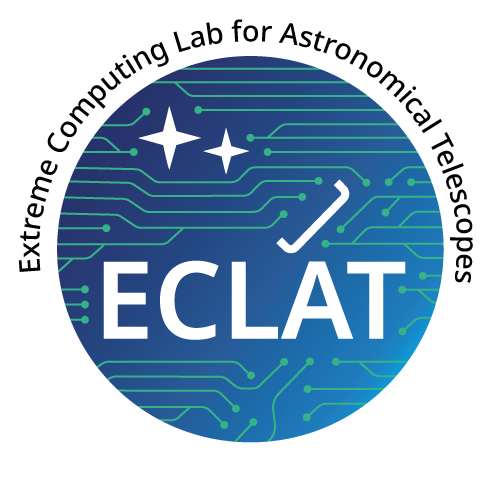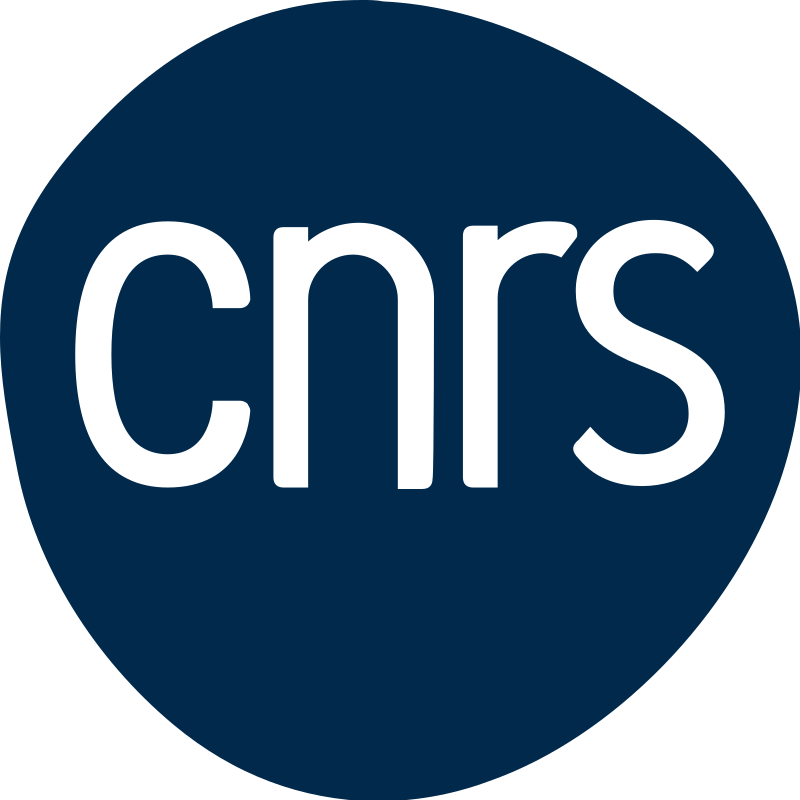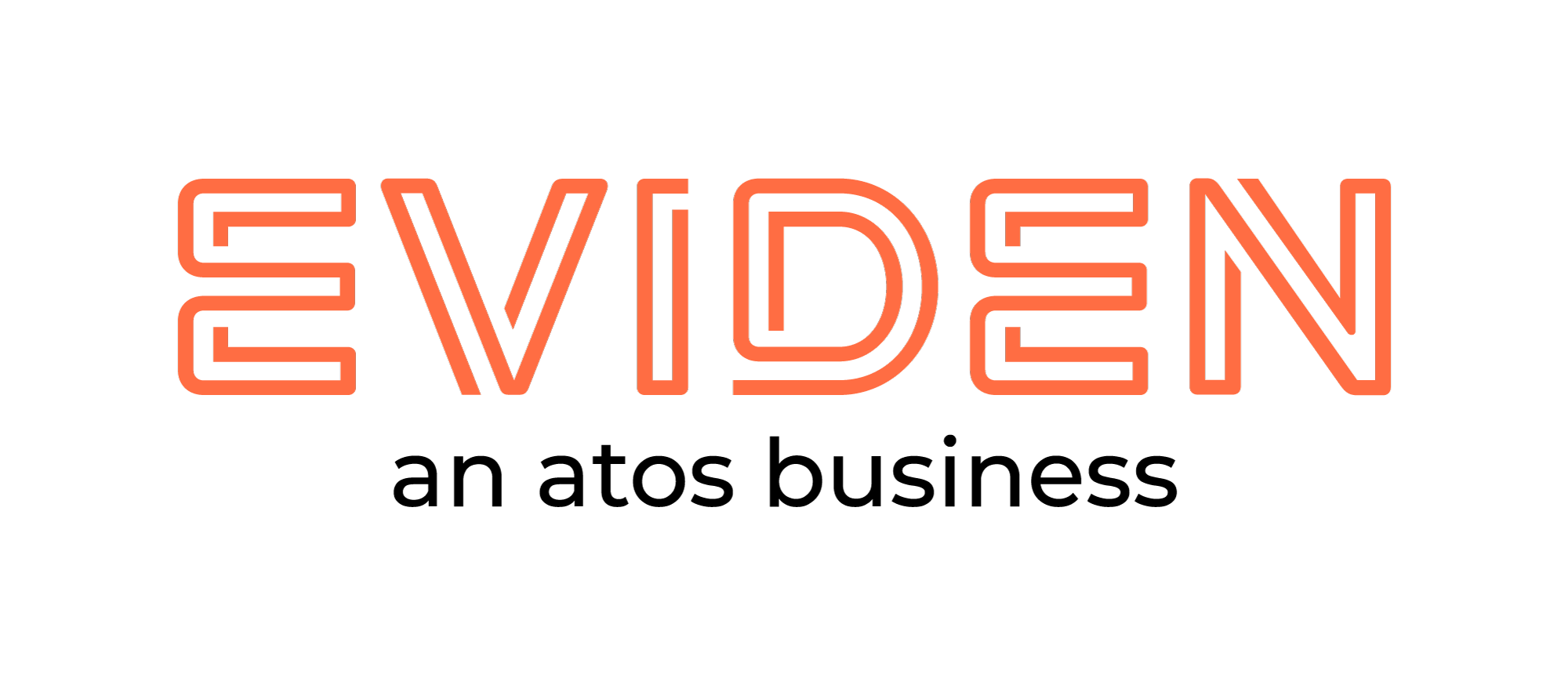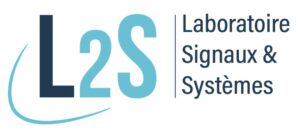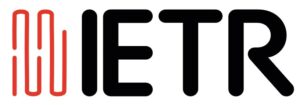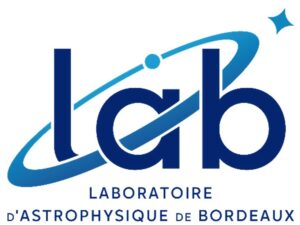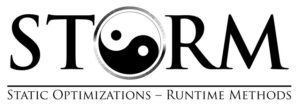Partner laboratories and research teams
Expertise from all over the country
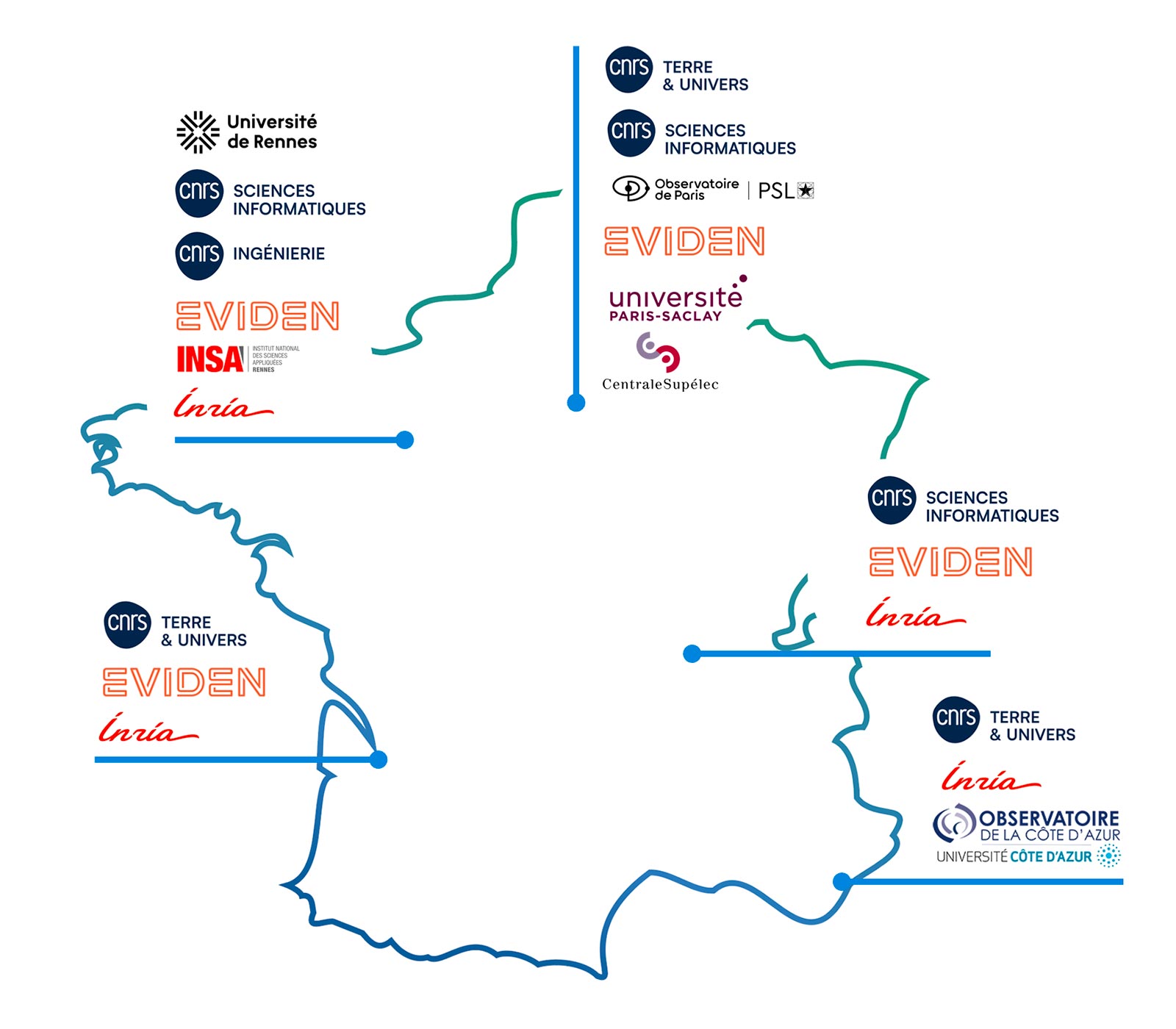
The 15 laboratories and teams are affiliated to the following research bodies and universities, which are signatories to the agreement to create this joint laboratory: CNRS, INRIA, Eviden, Observatoire de la Côte d’Azur, Observatoire de Paris, INSA Rennes, Université de Rennes, Université Paris-Saclay and CentraleSupélec.
Région Provence Alpes Côte d’Azur
- Lagrange and Galilée : Observatoire de la Côte d’Azur, CNRS
- INRIA : strategic partnerships
ECLAT laboratory partners
The National Centre for Scientific Research (CNRS) is one of the world’s leading research institutions. Its scientists explore life, matter, the Universe and the workings of human society to meet the major challenges of the present and the future. Internationally renowned for the excellence of its scientific work, the CNRS is a benchmark both in the world of research and development and for the general public.
Inria is France’s national research institute for digital science and technology. World-class research, technological innovation and entrepreneurial risk make up its DNA. More than 3,500 researchers and engineers across 200 project teams, most of which are jointly run with major research universities, are exploring new paths, often working across disciplines and in collaboration with academic and industrial partners to meet ambitious challenges.
Eviden is a next-generation technology leader specialising in reliable, sustainable and data-driven digital transformation, with a strong portfolio of patented technologies. Its position as a global leader in advanced computing, security, AI, cloud and digital platforms allows it to provide deep expertise across industries in more than 53 countries. Bringing together 57,000 world-class talents, Eviden extends the possibilities of data and technology across the digital continuum, today and for generations to come. Eviden is an Atos company with annual revenues of approximately €5 billion.
Learn more about Eviden's contribution
Researchers contributing to ECLAT
- Loris Lucido, GPU HPC Expert – CEPP
- David Guibert, HPC Expert – CEPP
- Erwan Raffin, Coordinator
- Sylvie Lesmanne, HPC HW Expert – R&D
- Grégoire Pichon, HPC Interco Expert – R&D
- Philippe Couvée, HPC Data Expert – R&D
Past, present and future activities sevring SKAO
Eviden, through its Centre for Excellence in High-Performance Programming (CEPP), has been involved in the SKA project for many years. The technical contributions focus on the study of performance and the parallelisation of imaging pipelines.
CEPP experts have worked on profiling the computation and input/output of the DDFacet imager, which is crucial for defining and sizing systems given the data throughput of around one terabyte per second and the constraint of temporarily storing minimal data. This preliminary study laid the foundation for future work on performance aspects related to input/output. This activity was continued by the LAB.
Furthermore, CEPP also contributed to the parallelisation of DDFacet to enable execution on a distributed memory system, as this code can only run on a single computing server. This parallelisation capability is necessary for large-scale use of DDFacet, i.e., when the data volume is too large to fit into a server’s internal memory. These efforts were presented at the second SKA France Day in November 2018 and in a research paper at the ADASS conference in 2020.
It is noteworthy that this work was further developed in the context of a PhD collaboration between L2S (CentraleSupélec), the Paris Observatory, and CEPP at Eviden, aiming to develop an implementation for use in the main branch of DDFacet to ensure usability and adoption by its users. This work[1] was published at the SIPS conference in 2022 but remains in a specific branch pending broader validation.
Eviden also took charge of, profiled, and improved the usage of DP3 and WSClean computational resources. This complex processing chain was installed, not without difficulty, on Eviden’s internal supercomputer. After identifying poor resource utilisation through DP3 performance analysis, CEPP developed a proof-of-concept using OpenMP to improve resource utilisation. The results were presented to SKAO in 2023.
Eviden has supported and taken ownership of the implementation of a Fast Sky-to-Sky Interpolation Method for Radio Interferometric Imaging (G2G). CEPP experts worked on cleaning up the G2G repository by removing dead code and unused scripts. Input path management was made more portable, and documentation was updated accordingly. Moreover, the CPU and GPU versions of G2G were tested and compared. It remains challenging to make precise comparisons of numerical results between the two versions (different test cases or colour scales). A CPU-only version of G2G was extracted, stripped of any GPU residues. This version was made publicly available on CentraleSupélec’s GitLab for public, unrestricted use.
Eviden also supports the ANR DARK-ERA project.
[1] https://doi.org/10.1016/j.ascom.2023.100767
The Observatoire de la Côte d’Azur is an internationally recognised centre for research into Earth and Universe sciences. Its mission is to contribute to advancing knowledge of the Universe through the systematic acquisition of observational data and the development and use of appropriate theoretical, experimental and technical resources in the fields of astronomy, geosciences and related sciences such as mechanics, signal processing and optics, as well as their applications.
Observatoire de Paris-PSL is a public institution responsible for fundamental and applied research, higher education and the sharing of knowledge in disciplines related to the sciences of the universe and astronomy. The Observatoire de Paris-PSL is made up of 800 researchers, engineers and administrative and technical staff who contribute to theoretical studies, instrumental innovation and observation services for large terrestrial telescopes, metrology and space missions.
Learn more about Observatoire de Paris' contribution
Researchers contributing to ECLAT
- Cyril Tasse, Imaging and calibration algorithms for large interferometers
Past, present and future activities serving SKAO
To solve these problems associated with the use of the SKA’s large precursor interferometers, over the last ten years we have developed innovative approaches equivalent to the implementation of wide-field adaptive optics generalised to polarisation. For the first time, this has made it possible to simultaneously and rapidly resolve perturbing effects in all directions of the sky, taking polarisation into account. This work required considerable algorithmic and computer development, leading to the creation of software capable of synthesising images corrected for ionospheric effects, among other things. We have applied these algorithms to the LoTSS-wide (Shimwell, Tasse et al. 2019, which aims to image the entire northern hemisphere) and LoTSS-deep (Tasse et al. 2021, which involves synthesising deep images of a few extragalactic fields) projects, during which we have generated images of a sensitivity and fidelity never before achieved. Although the LoTSS-wide survey is still under construction, it is already the largest ever carried out in the field of radio astronomy, with more than 4 million sources detected. These algorithms and software are now being used successfully on most of the world’s radio interferometers (ASKAP, MeerKAT, 21CMA, eVLA, uGMRT, ATCA etc), opening up a new window onto the Universe at low frequencies. This expertise is essential to the smooth operation of the new generation of interferometers, and enables us to participate in the scientific exploitation of numerous projects, some of which cut across our main areas of interest.
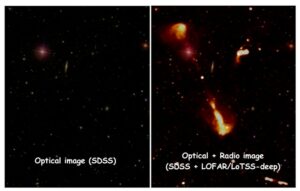
Fig. 1: Images of radio galaxies from a tiny part of a deep LoTSS-deep image (Elais-N1), superimposed on an optical image of the sky. We can see the jets produced by the Active Galactic Nuclei, as well as star-forming galaxies.
Research laboratories and teams
LESIA team (Observatoire de Paris, CNRS)
Researchers contributing to ECLAT
- Julien Girard
The institute
Some of the members of the LESIA HPA radio team are involved in the NenuFAR project, SKA’s pathfinder, producing data for a wide range of scientific cases in imaging and beamforming mode. The team also participates in LOFAR scientific projects and is involved in the European EXTRACT project.
Past, present and future activities serving SKAO
- Since January 2023, the EXTRACT project, “A distributed data-mining software platform for EXTReme dAta Across the Compute continuum”, aims to develop technical solutions for orchestrating the processing of data from radio telescopes on architectures. The solutions being explored include the management and dynamic allocation of computing resources and data partitioning. One of the objectives of the project is to test the scalability of future solutions for processing data stored on the SKA Regional Centres. The project covers the massive processing of imaging data as well as the detection and characterisation of transient sources detected in data streams (beamforming and imaging) using deep learning.
- September/October 2024: Finalisation of an initial Minimum Viable Product (MVP) covering the ingestion, orchestration and processing of radio imaging data.
- Using the NenuFAR scout to prepare the radio astronomy community to welcome SKA.
- Development of NenuFAR-DC (Data Centre) for object-based storage of NenuFAR radiotelescope data
LERMA team (Observatoire de Paris, CNRS)
Researchers contributing to ECLAT
- Carlo-Maria Zwölf, AI RI, scientific coordination and AI dissemination
- Florent Mertens, postdoctoral fellow and scientific partner
- David Cornu, postdoctoral fellow and scientific partner
- Gregory Sainton, AI RI, technical partner
- Aristide Doussot,HPC RI, technical partner
- Additional contributors: B. Semelin, P. Salomé, N. Moreau
The institute
The Galaxies and Cosmology team at LERMA (future LUX), Observatoire de Paris, PSL, primarily consists of researchers working on these themes. Part of the team uses radio interferometric data from major international instruments, and several researchers and engineers include SKA preparation in their research themes.
Past, present and future activities serving SKAO
- Study of the cosmic dawn (CD) and the epoch of reionisation (EoR). Use of a high-resolution numerical simulation code (LICORICE) to produce databases (LORELI) of 21cm signal power spectra corresponding to different possible universes. ‘Simulation-based inference’ to reconstruct the properties of the EoR using several methods (BNN, NDE, etc.). Combination with radio astronomical observations to place upper limits on cosmological models. This theme will benefit greatly from the sensitivity of the future SKA. Several researchers in the team are members of the SKA CD/EoR working group, the LOFAR-EoR project and the NenuFAR CD project.
- Processing and visualisation of massive data, participation in the development of processing chains for large radio instruments. Simulation of data and instrument processing chains. Development of innovative methods for the calibration and imaging of radio observations. Development of visualisation tools (YaFITS) and database exploration tools for ALMA (ARTEMIX). Participation in the SKAO orange team for the development of visualisation tools. Participation in the SKAO SCOOP team for the co-design of SRC/SDP and SKA processing chains.
- Source detection and statistical analysis of galaxy properties using deep learning. Development of custom object detectors for the detection and characterisation of sources (YOLO-CIANNA) in massive radio surveys. Development of tools-services for real-time extraction of sources and to facilitate exploration of high-dimensional data. Development of statistical learning tools for data mining and statistical analysis of large galaxy surveys.
- Participation in SKA SDCs. The group has participated (or rallied a posteriori) and consistently obtained 1st or 2nd place in SDC1 (MINERVA), SDC2 (MINERVA) and SDC3a (DOTSS-21). The group has currently registered two teams for SDC3b and intends to continue participating in future editions in order to stimulate the development of new analysis methods.
Laboratoire Signaux & Systèmes (CNRS, Centrale Supelec, Université de Paris Saclay)
Researchers contributing to ECLAT
- François Orieux, , “Application Algorithms” Coordinator
- Mohammed Nabil El Korso
The institute
The Signals and Systems Laboratory has renowned expertise in statistical signal processing, antenna processing, inverse problems and computational imaging. The laboratory has worked on developing new statistical signal processing methods, Bayesian and variational approaches, robust statistics and statistical learning for image estimation and reconstruction, particularly in inverse problems. The laboratory is involved in the SKA project through the ANR Dark-Era project (2021-2025), which focuses on HPC simulation for the design of a heterogeneous computing cluster for SKA, as well as several theses on data calibration and the acceleration of image reconstruction algorithms.
Past, present and future activities serving SKAO
- ANR Dark-Era on HPC prototyping for SKA.
- Nicolas Monnier’s thesis in collaboration with ATOS (Eviden)
- G2G algorithm for accelerating gridding and degridding for image reconstruction.
[1] N. Monnier, F. Orieux, N. Gac, C. Tasse, E. Raffin, and D. Guibert, “Fast Grid to Grid Interpolation for Radio Interferometric Imaging,” Astronomy and Computing, vol. 45, p. 100767, Nov. 2023, doi: 10.1016/j.ascom.2023.100767. - Jianhua Wang’s thesis : Antenna desing for interferometer arrays, soutenance prévue 2025)
- Nawel Arab’s thesis : Maximum likelihood and informed learning for dynamic imaging in radio astronomy (defence due in 2025)
- Yassine Mhiri’s thesis : Contributions to calibration and imaging methods for radio interferometers in the presence of interference (soutenue 2023)
The laboratory is interested in continuing its work in:
- Computational imaging
- Bayesian approach
- Machine learning for image reconstruction
- Unsupervised approach and self-calibration
- Quantifying uncertainties
The laboratory is interested in collaborations to:
- Test algorithms
- Develop new applications for its algorithms
- Receive new issues related to data analysis and processing algorithms, whether using statistical or machine learning approaches.
SATIE laboratory (CNRS, Université de Paris Saclay)
Researchers contributing to ECLAT
- N. Gac
- L. Bacharah
- P. Larzabal
- I Vin
- T. Rodet
The institute
Computational imaging for radio astronomy is a cross-disciplinary theme of the SICOIA and SIEU teams in the Information and Energy Technology Systems and Applications (SATIE) laboratory. SATIE is drawing on its expertise in both signal processing and algorithm-architecture matching to meet the computational challenges of new-generation radio telescopes. In signal processing, work focuses on imaging techniques, dynamic imaging, calibration, finding optimal geometries, switching sub-networks and informed learning.
The aim of the work on algorithm-architecture matching is to better understand and scale up algorithms. Working closely with L2S, SATIE brings this dual expertise to ECLAT joint lab and the ANR Dark-Era consortium. With a focus on the application side of its work, SATIE is developing a collaboration with the Nançay Observatory (ORN), where NenuFAR, an SKA precursor, is located.
IETR laboratory (CNRS, INSA, Centrale Supelec, Université de Rennes)
Researchers contributing to ECLAT
- Jean-François Nezan, IETR Scientific Lead, Calculation models, video compression, and signal processing for astronomy
- Karol Desnos, Calculation models, AI, and memory optimisation
- Mickael Dardaillon, Calculation models, Compilation and reconfigurable architecture
- Maxime Pelcat, Cybersecurity and sustainable electronics calculation models
- Daniel Ménard, Approximate computation and energy consumption
- Christophe Moy, Software Radio, Cognitive Radio
- Jordane Lorandel, Embedded system architecture (MCU, SoC, FPGA)
The institute
- IETR: Institute of Electronics and Digital Technologies
- UMR CNRS 6164
- Disciplines: Antennas and microwave devices, EMC and electromagnetism, multifunctional materials, microtechnologies and microsensors, digital communications, remote sensing and multimodal imaging, image analysis and processing, automation, energy systems, lifecycle and eco-design of electrical systems
Activities carried out serving SKAO
- With AUT (NZ) and Kalray: Evaluation of MPPA on SKA CSP algorithms (FFT – correlation), Dataflow modelling of the SEP processing chain for SKA SDP
- With the Paris Observatory: Dataflow modelling of calibration algorithms (Cyril Tasse – KillMS)
Ongoing activities serving SKAO
- ANR Dark-Era project: Extension of dataflow simulation tools (PREESM) for heterogeneous HPC targets (L2S, INRIA, OP, OCA)
- MSCA Rising Stars project:
- Application modelling with partners MicroGATE and CSIRO;
- Extension of dataflow programming models/OpenMP with BSC;
- Design and programming of dedicated computing systems with the Paris Observatory
Future activities serving SKAO
- Use case: Embedded AI and SPML (Signal Processing + Machine Learning) systems
- Integration of dataflow methods in MLIR-based compilation chains
- Hardware: GPU, heterogeneous HPC systems (CPU/GPU/FPGA), computing continuum
IRISA laboratory's Logica team (CNRS, INSA, Université de Rennes)
Researchers contributing to ECLAT
- François Bodoin, Links with work carried out under the Numpex/Exa-AToW project
- Mathis Certenais, Work on the DDF pipeline as a use case for data logistics
The institute
Irisa, which is structured into seven scientific departments, has positioned itself as a centre of research excellence. Its scientific priorities include bioinformatics, systems security, new software architectures, virtual reality, mass data analysis and artificial intelligence.
Past, present and future activities serving SKAO
The Exa-AToW roadmap for the SKA SRC project presents a strategy for testing interoperable solutions for executing large-scale workflows with the SKA processing pipeline (or its precursors). The aim is to develop workflow simulation methods to improve the orchestration of multiple processing pipelines on distributed architectures. This approach includes the study of existing example pipelines, the extraction of runtime data, the rewriting of workflows in an appropriate language (such as CWL), and the implementation of agent-based simulations representing computing resources and workflow tasks. Various scenarios will be tested, including the competition of multiple workflows for system resources, the impact of failures in the processing chain, variations in network bandwidth, and the estimation of solution time in relation to the carbon footprint. Short-term tasks include studying current implementations, expressing pipelines in workflow languages, and implementing agent-based simulations, while medium-term tasks aim to integrate optimised versions of pipelines and run them on HPC machines.
KerData team (INRIA, INSA Rennes, ENS Rennes)
Researchers contributing to ECLAT
- Gabriel Antoniu, Coordinator of the PEPR NumPEx Exa-DoST project, under which the KerData team is involved in ECLAT
- François Tessier, Responsible for batch 1 of the Exa-DoST project (PEPR NumPEx)
The institute
KerData s a joint research team of the Inria Centre at Rennes University, INSA Rennes and IRISA laboratory. Its research focuses on data storage and processing on the Edge-Cloud-HPC continuum.
Past, present and future activities serving SKAO
- Exa-DoST: As part of ECLAT, the KerData team is mainly involved in collaborative activities with the CNRS, the Observatoire de Paris and the Observatoire de la Côte d’Azur as part of the Exa-DoST project of the NumPEx PEPR (2023-2029). In this project, SKA is one of the two application demonstrators driving joint research into the challenges of scaling storage architectures, input/output management and in situ analysis. Learn more.
- Summer 2024: Ugo Thay’s engineering internship in the context described above on a study of the input-output schematics of Quartical (a component used in the SKA pipeline).
- InPEx: The InPEx initiative is part of the international collaborative actions of the NumPEx PEPR. KerData (Gabriel Antoniu) is co-leading the working group dedicated to the challenges of the digital continuum in the post-exaflop age. At the InPEx workshop held in Barcelona in July 2024, SKA was presented as a representative use case.
Lab laboratory (CNRS)
Researchers contributing to ECLAT
- Antsa Rasamoela, Link with Numpex/Exa-DoST project work
- Valentin hazard, Benchmarking works on CPU and I/O for DDFacet and killMS imaging software
The institute
The SE2I (Electronic Systems and Instrumental Computing) team at the Bordeaux Astrophysics Laboratory (LAB) has technical expertise in digital signal processing for radio astronomy, particularly through its contributions to the construction of the ALMA radio telescope. Over the last decade, LAB has led several development studies funded by ESO to explore various digital technologies in preparation for second-generation ALMA instrumentation. This expertise, primarily based on FPGA technology, now also includes CPUs and GPUs. One of the main challenges for the next generation is high-speed data transfer between different hardware resources within a heterogeneous system. The SE2I team has gained solid experience in data transport from digitizers to FPGAs and between FPGAs, and is now exploring data transfer between FPGAs and GPUs. Lastly, the team contributes to the Exa-DoST project under the PEPR NumPEx framework by studying and designing an exascale-level application demonstrator tailored to SKAO’s data processing requirements.
Past, present and future activities serving SKAO
- Study and development of a suite of tools dedicated to benchmarking radio imaging applications:
- CPU performance benchmarking applied to the DDF pipeline (DDFacet + killMS) software, using processor load trace tools.
- I/O benchmarking for DDFacet through an M2 internship by Iheb Becher (2024). Development of visualisation and I/O trace tools using Darshan API.
- Study of a reproducible deployment solution for DDFacet and killMS software (Spack, Guix, etc.).
Labri team - STORM laboratory (INRIA, CNRS)
Researchers contributing to ECLAT
- Olivier Aumage, Supervision of a Master 2 computer science course at the University of Bordeaux on task scheduling in the DDFACET software
The institute
- Inria Centre at Bordeaux University, STORM team.
- The STORM team is working on the design of methods and tools for optimising intensive computing applications, involving in particular paralleling and scheduling techniques via task-based execution media such as StreamPU and StarPU. The STORM team is involved in the NumPEx PEPR, in the Exa-SofT focus project.
Past, present and future activities serving SKAO
- 2024 activities — Supervision of a Master 2 Computer Science internship at Bordeaux University:
- Packaging of DDFACET software dependencies with the GNU GUIX package manager to enable direct and reproducible installation of DDFACET on computing machines supporting GNU GUIX without using a Docker / Singularity type container.
- Preliminary exploration of interfacing DDFACET software with StreamPU (ex-AFF3CT Core) task-based execution support for pipelined execution on multicore architecture.
Labri team - Tadaam laboratory (Inria)
Researchers contributing to ECLAT
- Francieli Zanon-Boito
- Luan Teylo
The institute
- Inria Centre at Bordeaux University
- Data management in HPC platforms and applications
Past, present and future activities serving SKAO
Working with the Laboratoire d’Astrophysique de Bordeaux to characterise the input/output (I/O) behaviour of the DDFacet application. We have carried out executions on the PlaFRIM platform using the Darshan profiling tool and have identified that the read time corresponds to around 15% of the execution time, and that the application writes a lot of data to a so-called ‘cache’ directory. New experiments will be necessary because the Darshan tool has not proved suitable for a Python application such as DDFacet. This work will continue in the context of NumPEx – PC3 Exa-DoST with DDFacet and other SKA pipeline applications.
LIP team - Avalon laboratory (INRIA & CNRS)
Researchers contributing to ECLAT
- Christian Perez, R&D Manager
- Anass Serhani, HPC Research Engineer
The team
The Inria-CNRS-ENSL-Univ Lyon I Avalon team based at LIP, ENS Lyon, focuses on efficiently executing parallel and/or distributed applications on parallel and/or distributed resources, such as supercomputers or clouds. The challenge is to define application models, systems, and algorithms to execute applications under user constraints (price, performance, etc.) and system administrator constraints (maximising resource use, minimising energy consumption, etc.). The team particularly tackles profiling and modelling energy consumption and data access, data management, component-based application modelling, and application placement and scheduling. Theoretical results are validated through simulations or experiments on Grid’5000 or production platforms.
Past and present activities serving SKAO
- Observer at the Critical Design Review (CDR) of the SDP consortium in January 2019 for France
- Participation in SKAO activities since 2020
- Active involvement in software co-design in SKAO’s Agile Software Engineering organisation: Development of a multi-level benchmarking suite, covering basic testing functions to entire pipelines/workflows, and Benchmarking of radio astronomy pipelines for self-calibration and imaging (DP3, WSClean, RASCIL,…)
- Participation in various WGs for initiating the French node (SRC-FR) in the SKA Regional Centres (SRCNet) network
Future activities serving SKAO
- Participation in the European ODISSEE project, particularly for SKA-SLICES links
- Energy characterisation and optimisation of radio astronomy pipelines.
- Lifecycle analysis and sustainability of Science Processing Centres (SPC).
LIP team - ROMA laboratory (INRIA)
Researchers contributing to ECLAT
- Frédéric Vivien
The institute
The joint CNRS-ENS de Lyon-INRIA-UCBL ROMA project-team aims to define scheduling models, algorithms and strategies to optimise the execution of applications on high-performance computing platforms. More specifically, ROMA seeks to obtain the ‘best’ possible performance from the user’s point of view (e.g. the shortest execution time) while using resources as efficiently as possible (e.g. minimising energy consumption). The work carried out by the team ranges from theoretical studies to the development of software tools.
Past, present and future activities serving SKAO
- Study of the complexity of scheduling radio astronomical observations (Mathis Lamiroy’s Master 2 internship, 2023) and future study of parametric complexity (Maher Mallem’s post-doc, starting in November 2024).
- Predictive maintenance planning as part of the ODISSEE project
- Previous work that can serve as a basis:
- Optimisation of the placement of so-called checkpoint backup points by taking into account fault predictions. Guillaume Aupy, Yves Robert, Frédéric Vivien, Dounia Zaidouni : “Checkpointing algorithms and fault prediction.” J. Parallel Distributed Comput. 74(2): 2048-2064 (2014)
- Steady-state scheduling (Loris Marchal’s thesis, etc.)
Lagrange and Galilée laboratories (Observatoire de la Côte d’Azur, CNRS)
Researchers contributing to ECLAT
- André Ferrari, Professor, Lagrange Laboratory, participation in Dark Era and SEAMS projects
- Shan Mignot, Project Manager IR, Lagrange Laboratory, coordination with SKAO developments for SDP software and hardware acquisition, participation in Dark Era, SEAMS, and Exa-DoST projects
- Alain O’Miniussi, HPC IR, UAR Galilée, participation in Exa-DoST project
- Simon Prunet, CR, Lagrange Laboratory, participation in Dark Era project
- Sunrise Wang, postdoctoral fellow, Lagrange Laboratory, participation in Dark Era and Exa-DoST projects
The institute
The Observatoire de la Côte d’Azur is an EPSCP Grand Establishment, « component institution » of Université Côte d’Azur. The Observatoire de la Côte d’Azur groups and oversees Earth and Universe sciences research activities of Université Côte d’Azur. Its missions include research, observation, education, and the dissemination of knowledge in these fields.
The Observatoire de la Côte d’Azur is co-supervisor of three joint research units(Artemis, Géoazur, Lagrange) and one service unit (Galilée). In this way, the OCA is building an institutional strategy that is in line with the main thrusts of the Earth and Universe sciences at national and European level. The OCA’s mission is to contribute to the advancement of knowledge of the universe through the systematic acquisition of observational data and the development and use of appropriate theoretical, experimental and technical resources in the fields of astronomy, geosciences, related sciences and their applications; to provide services related to the institution’s research activity; to contribute to the initial and continuing training of students and all research staff; to contribute to the dissemination of knowledge, particularly among teaching staff and users of the public education service; and to implement international cooperation activities, particularly at European level.
Past, present and future activities serving SKAO
Since 2008, the Observatoire de la Côte d’Azur has been deeply involved in cutting-edge research on cosmology and extragalactic astrophysics through SKA and its precursors, as well as the development of new interferometric imaging techniques in radio astronomy.
The OCA contributed to the design of SKA’s two telescopes during the pre-construction phase, participating in key committees organised by the SKAO office, such as:
- SKA-Athena Synergy Team
- SKA Science Assessment Team « Impact of SKA-Low antenna frequency coverage »
- Critical Design Review du consortium Low-Frequency Aperture Array de SKA en charge de concevoir SKA-LOW
- Council Preparatory Task Force
- Board de SKA Organisation
Today, the OCA plays a major role in the construction of the SKA by steering the hardware-software co-design of the future SKAO supercomputers that will produce the scientific data distributed to the community. In addition to technical and financial feasibility, this effort is aimed at sustainable management of this sub-system in terms of both its energy consumption and the environmental impact of its life cycle.
The OCA is one of the five founding academic partners of SKA-France coordination in 2016 (OCA, OP-PSL, Université de Bordeaux and Université d’Orléans, with CNRS/INSU as lead partner) and one of the signatories of the ‘Maison SKA-France’ academic partnership between 2018 and 2020. Chiara Ferrari of the OCA has been in charge of SKA-France since its initial phases and is one of the two French representatives on the SKAO Board, giving the OCA an important role in the governance of the project at national and international level.
List of the main SKAO projects in which the OCA is involved:
- ANR J.CJ.C OPALES project « nOn-thermal Processes in gALaxy clustErS » – 2009-2014 (P.I. C. Ferrari, OCA)
- ANR Generic MAGELLAN project « Machine learning methods for the very large arrays in radio astronomy » – 2014-2018 (P.I. A. Ferrari, OCA)
- H2020 AENEAS project « Advanced European Network of E-infrastructures for Astronomy with the SKA »- 2017-2019 (P.I. for France and Chair of the project’s G.A.: C. Ferrari, OCA)
- ANR Dark-Era project to develop and evaluate algorithmic and hardware solutions for Science Data Processors – 2021-2025
- ANR-SNFS SEAMS « Sustainable & Energy Aware Methods for SKA » – 2024-2027
- Horizon Europe SPECTRUM project «Computing Strategy for Data-intensive Science Infrastructures in Europe» – 2024-2026 (P.I. pour la France: C. Ferrari, OCA)
- PEPR NumPEx, PC3 Exa-DoST « Data-oriented Software and Tools for the Exascale» 2023-2028
Research areas
Pushing the limits of innovation
Design of supercomputers
Research & development
Instrumentation for radio astronomy
Contributions to SKAO
Want to learn more?
Find out how you can contribute to innovation in astronomical research with ECLAT. Explore our pioneering projects and international collaborations to push back the frontiers of modern astronomy.
